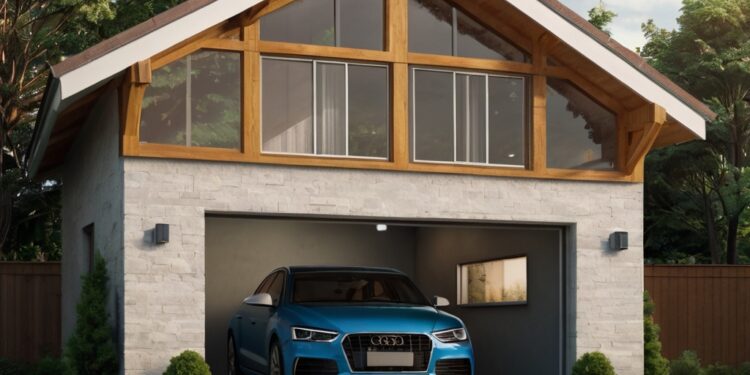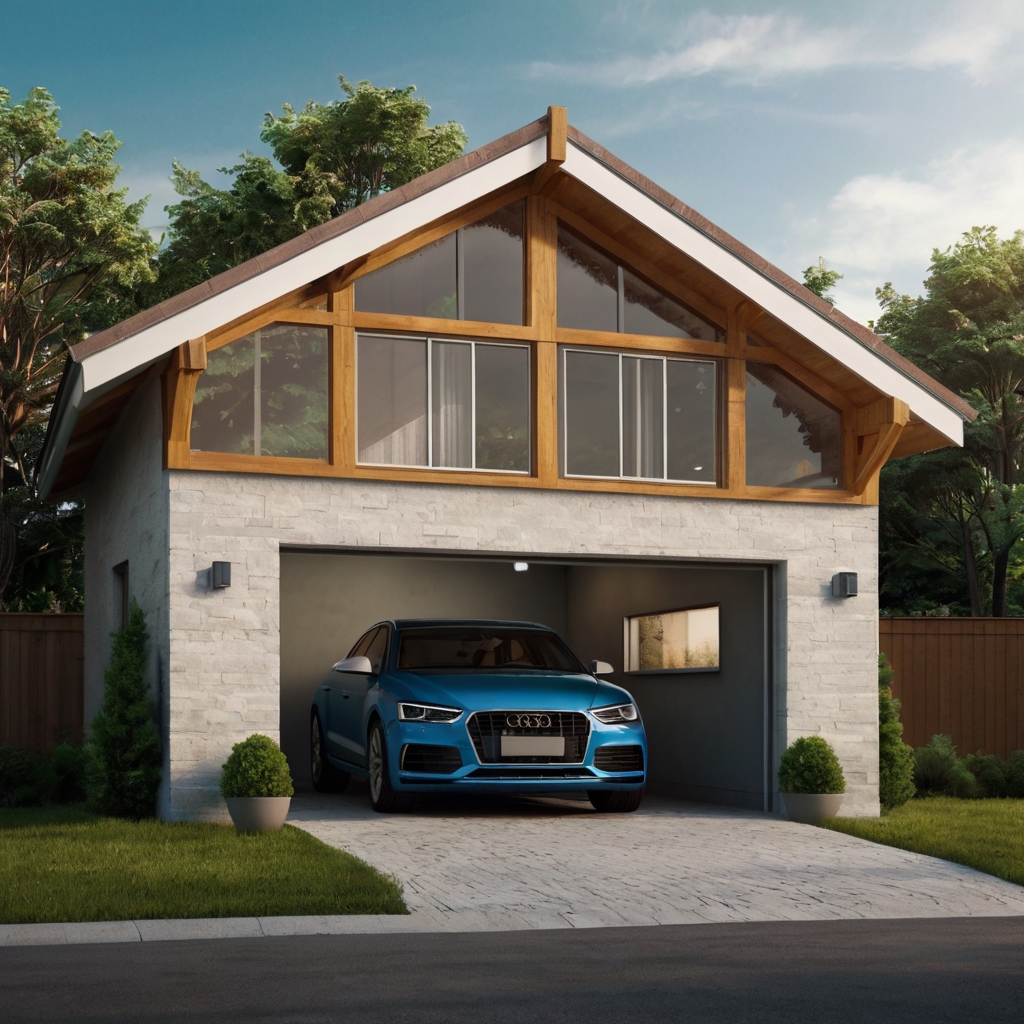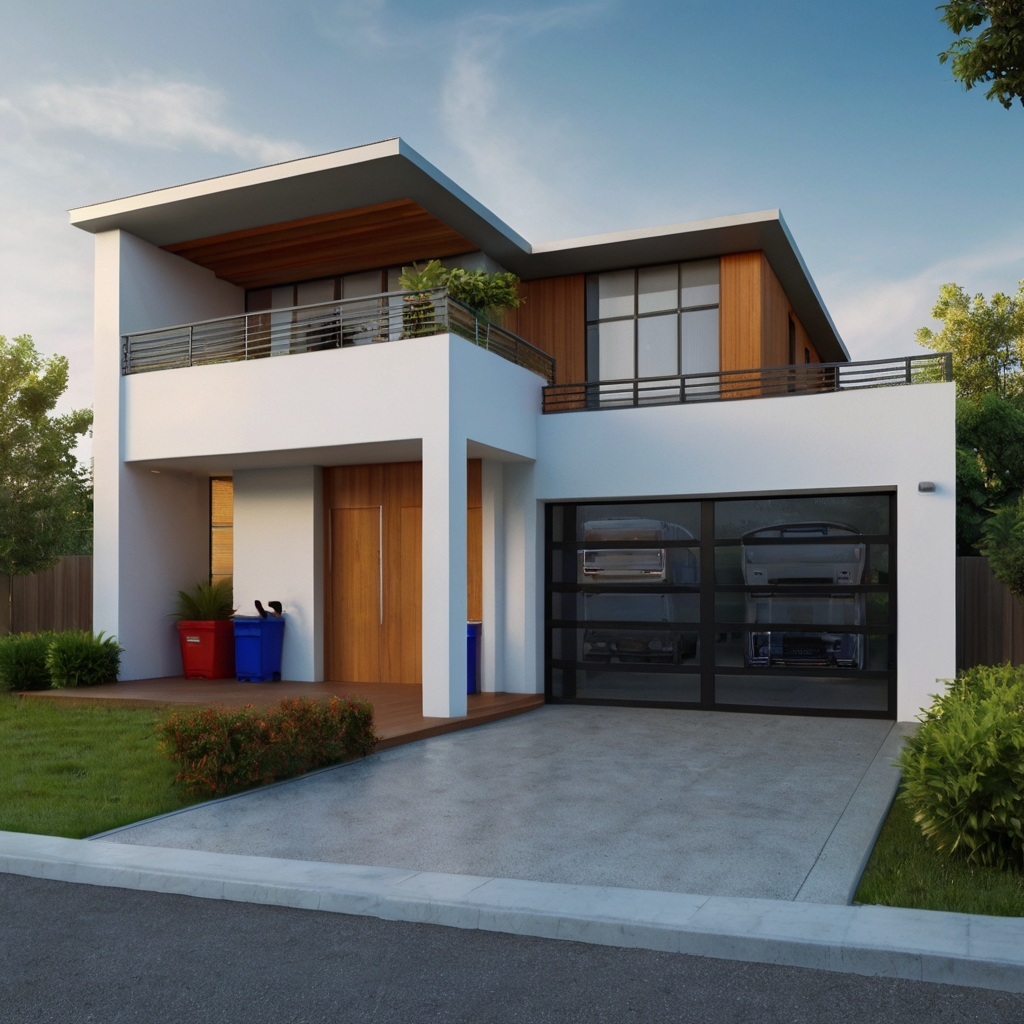Standard Two Car Garage Size

Two-car garage sizes show more variation than most homeowners might expect. The minimum dimensions start at 20×20 feet (400 square feet), yet many families find this simple size too restrictive for parking and accessing their vehicles.
The average two-car garage measures between 24×24 feet (576 square feet) and 24×30 feet (720 square feet). These dimensions offer enough room for vehicles, storage space and easy movement. Several common size categories exist for standard two-car garages: 20×20 feet, 22×22 feet, 24×24 feet, or 28×28 feet. California’s average size measures approximately 22×22 feet. Homeowners should evaluate their vehicle specifications, storage requirements, and local building codes to determine the ideal garage size. This complete guide details everything about two-car garage dimensions that helps readers make smart choices about this crucial home addition.

Table of Contents
- 1 What is a Standard Two Car Garage?
- 2 Typical Dimensions of a 2 Car Garage
- 3 How Vehicle Size Affects Garage Dimensions
- 4 Planning for More Than Just Parking
- 5 Other Factors That Influence Garage Size
- 6 Summing all up
- 7 Here are some FAQs about standard two car garage size:
- 7.1 What is a standard size 2 car garage?
- 7.2 Is a 24×24 garage big enough?
- 7.3 What size door is the normal size for a two car garage?
- 7.4 How much space do you need for a 2 car garage?
- 7.5 Is 18 ft wide enough for a 2-car garage?
- 7.6 What is the most cost effective garage size?
- 7.7 Is 30×30 a good size garage?
- 7.8 What is the cost to build a 24×24 garage?
- 7.9 Is a 20×20 garage big enough for two cars?
What is a Standard Two Car Garage?
A standard two-car garage gives you dedicated space to store and protect vehicles. It fits two average-sized cars with enough room to move around them. These structures do more than just house your cars – they’re great for storage, work, and sometimes even entertainment.
Definition and purpose
A “standard two car garage” is a permanent structure with walls and a roof that fits two vehicles side by side. Unlike temporary shelters or carports, it keeps your vehicles and belongings safe from weather and theft. The smallest viable size starts at 20×20 feet (400 square feet), though most people need more space than this minimum.
Most homeowners find that a two-car garage strikes the right balance between function and space. These structures serve several key purposes:
- Vehicle protection from weather, theft, and vandalism
- Storage for seasonal items, tools, and equipment
- Workspace for hobbies, repairs, and projects
- Buffer zone between outdoors and home interiors
The garage often connects to your home’s utilities. This is especially true for attached models that share electrical, plumbing, or HVAC systems with the main house.
Attached vs. detached garages
The main difference in two-car garage design comes down to whether it connects to your house or stands alone. Each style has its benefits based on your property layout, budget, and needs.
Attached garages share a wall with your house and become part of the main structure. You’ll usually find a “person door” or “man door” that lets you walk straight into your home. These garages cost less to build since they use the house’s existing walls and systems.
Detached garages stand separate from your house. They give you more freedom with placement and design. While they’re common in rural areas and older homes, detached garages work well for properties with specific layout needs or style priorities.
Your choice between attached and detached designs depends on:
- Convenience: Attached garages let you stay dry when the weather’s bad
- Space constraints: Smaller lots work better with attached designs
- Design flexibility: Detached structures give you more options for size and style
- Future expansion: Detached garages are easier to expand later
- Privacy and noise reduction: Separate buildings keep workshop noise away from your home
Why size matters for usability
The size of your two-car garage affects how you can use it beyond just parking cars. While minimum sizes fit two vehicles, they leave little room for anything else.
Standard garage sizes start at 20×20 feet, but more comfortable options range from 22×22 feet up to 28×28 feet. A 24×24-foot garage gives you much more usable space than the minimum size.
Size becomes crucial when you think about:
- Vehicle clearance: Today’s SUVs and trucks need more room than regular cars
- Door access: Space to open car doors fully
- Walkway space: Safe paths around your vehicles
- Storage needs: Wall space for shelves and cabinets
- Workspace requirements: Room for workbenches or exercise gear
Many homeowners find that going bigger – like 24×32 feet or even 30×40 feet – gives them the best mix of parking and extra space. This extra investment often pays off through better usability and higher property value.

Typical Dimensions of a 2 Car Garage
Finding the right size for your garage means you need to balance vehicle space with storage and movement needs. The standard two car garage comes in different sizes. Let’s look at your options to help you make the best choice when building or buying a home.
Minimum size: 20×20 ft
A standard two car garage starts at 20×20 feet with 400 square feet of space. This basic footprint is just enough to fit two vehicles side by side. In spite of that, you’ll have little room to move between cars or store extra items.
A 20×20 garage works fine for compact cars. The space gets tight with SUVs or trucks. You’ll need to park with precision to avoid door dings, which can be frustrating daily. It also leaves no room for storage, workbenches, or walking space.
Average size: 24×24 ft
The most popular two car garage size is 24×24 feet, giving you a comfortable 576 square feet. This size hits the sweet spot between function and space for most homeowners. You can park two cars and still have room to open doors and walk between them.
A 24×24 garage gives you:
- Easy parking for two standard vehicles
- Space to open doors without hitting other cars
- Room for wall storage systems
- A spot for a small workbench
This size works great for average-sized vehicles and strikes a good balance between cost and function. It also fits most building codes and neighborhood standards without special permits.
Larger options: 24×30 ft and beyond
Looking for more than just car storage? Larger two car garages starting at 24×30 feet (720 square feet) give you much more flexibility. The extra space lets you add storage, create workshop areas, or fit bigger vehicles.
Big two car garages at 24×30 ft offer:
- Space for two SUVs or trucks
- A good-sized work area at the back
- Lots of room for tools and equipment
- Space that adapts to future vehicle needs
Some people go even bigger with 28×28 or 28×40 sizes to combine workshop space with car storage. These larger sizes work best for hobbyists, mechanics, or anyone needing lots of storage.
Standard two car garage door size
A typical two car garage door is 16 feet wide and 7 feet high. This standard size lets two vehicles use a single opening. Some homeowners choose two separate single doors instead, each 8 to 9 feet wide.
One double door has its perks:
- Looks better from outside
- Needs just one opener
- Costs about the same as two single doors
Garage doors need specific clearances to work right. You need 6 inches above the door and 14-18 inches of ceiling space for opener systems.
Ceiling height and clearance
Most two car garages have 8 to 9-foot ceilings. This height works for most cars and often allows overhead storage. Many builders suggest going with 10-foot ceilings for more options.
Higher ceilings give you:
- Room for tall SUVs and vans
- Space for overhead storage
- Better air flow
- Options for lifts or equipment later
Building codes set minimum headroom rules, especially for door operation and safety. Modular garage makers usually keep total height under 13’6″ for shipping.
How Vehicle Size Affects Garage Dimensions
Your choice of vehicles plays a big role in determining the right size for a standard two-car garage. The relationship between car sizes and garage space needs will determine whether you’ll enjoy years of easy parking or face daily challenges.
Compact vs. full-size vehicles
The space needs change a lot when you switch from parking compact cars to larger vehicles. Compact cars usually measure 14-16 feet long and 5-6 feet wide, taking up about 90 square feet of garage space. Full-size vehicles are bigger at 16-18 feet long and 6-6.5 feet wide, using up about 150% more space than compact cars.
A 20×20 garage works well for two compact cars like the Honda Civic (15.4 feet long, 5.9 feet wide). But this size becomes tight for two full-size vehicles, leaving barely any room to move between them.
SUVs, trucks, and clearance needs
Larger vehicles need much more space in a standard two-car garage. SUVs usually measure 15-19 feet long and 6-7 feet wide, while full-size trucks can stretch beyond 20 feet. The Ford F-150 reaches 20.25 feet in its longest form with a width of 7.9 feet, taking up about 160 square feet of garage space.
Height matters just as much as floor space. Regular 8-foot garage ceilings work fine for most sedans. Trucks and SUVs with roof racks often need 9+ foot ceilings. Experts suggest at least 24×30 dimensions for larger vehicles to give enough clearance all around.
Space for opening doors and walking around
A garage needs proper clearance around vehicles to work well. Plan for 2-3 feet of space on all sides of each vehicle. Two cars side-by-side need about 6-9 extra feet beyond their combined width.
You’ll want at least 36 inches between parked vehicles so doors can open without hitting each other. Add in the space needed behind vehicles, and you can see why 24×24 makes the most sense as a standard two-car garage size for average vehicles.
Truck owners who need to work around their vehicle should go for a 30-foot garage depth. This extra space means you’ll have room not just to park but to use your garage fully for years to come.
Planning for More Than Just Parking
A well-designed two car garage offers more than just vehicle storage – it can become a flexible extension of your living space. Smart planning helps you make the most of standard two car garage dimensions, giving you plenty of room for storage, hobbies, and whatever the future brings.
Storage needs: bikes, tools, shelves
Wall space plays a significant role in garage organization. Wall-mounted shelving systems let you employ the full height of your walls instead of just the floor. You can create a solid foundation by installing three-quarter-inch plywood over drywall or bare studs, which gives you a continuous surface to mount storage hardware anywhere.
Smart bike storage solutions keep your space tidy while making bikes available:
- Ceiling-mounted hoists lift bikes up and away
- Wall-mounted hooks or racks display bikes vertically
- Sliding track systems nest multiple bikes together and save up to 40% of space
Long-handled tools like rakes and shovels need their own storage spots to keep the floor clear. Space-saving wall-mounted racks can hold up to 14 items vertically.
Adding a workbench or hobby space
A rolling workbench works great for garages that serve multiple purposes. You can quickly switch between parking space and workshop. DIY enthusiasts benefit from a small desk area that serves as a planning station for notes and project development.
Different needs call for different layouts. Placing workbenches along side walls keeps your garage’s depth free for vehicles. A workbench height of 42 inches (matching “belly-button height”) keeps you comfortable during long projects.
Considering future vehicle upgrades
Modern transportation keeps evolving, and your garage should keep pace. A resilient electrical system that supports EV chargers makes your garage ready for the future. The layout of your storage systems should adapt to changing vehicle sizes.
Modular storage components give you the flexibility to adjust as your needs change. Garages with adaptable storage stay functional even as transportation trends change toward larger vehicles or new technologies.
Other Factors That Influence Garage Size
Your garage project’s final dimensions depend more on regulatory and practical constraints than vehicle size priorities. Several external factors guide homeowners as they plan their ideal garage space.
Local building codes and permits
Building a standard two car garage needs permits, and regulations differ by location. Local laws require permits for garages bigger than 120 square feet. Zoning laws set key parameters like setbacks—minimum distances your garage must maintain from property lines. Most areas limit garage door width to 10 feet because of curb cut rules. This affects how you design two car garage entrances.
The law takes these requirements seriously. Homeowners who break these rules face fines, construction stops, or jail time in extreme cases. You’ll need separate approvals for electrical or plumbing work beyond the standard building permit. A visit to your local planning department before finalizing garage plans is a smart first step.
Lot size and property layout
Your property’s physical limits determine what’s possible for your garage. Local rules usually cap detached garages at 720 square feet or half the home’s heated space. These structures can’t be taller than 1.5 stories or 16 feet above grade.
The driveway needs careful planning too. Single garages need an extra 10 feet of driveway space, while standard two car garages need 20 feet. Fixing a too-small driveway after construction costs thousands.
Cost implications of larger garages
Bigger garages cost more money—you’ll pay for extra materials and labor. Other costs include:
- Foundation work for wider spans
- More materials for larger square footage
- Permit fees between $200 and $2,000 based on project size
- Possible driveway expansion costs
Prefab vs. custom-built options
Homeowners must choose between prefabricated and custom-built garages. Prefab structures come pre-built or in sections and save money compared to traditional construction. These units cut costs by avoiding full design and construction crews.
Custom-built options give you more flexibility for specific storage needs or multiple vehicles. This choice works best for homeowners with unique requirements or larger vehicle collections.
Summing all up
The size of a standard two-car garage stands among a homeowner’s most critical building or renovation decisions. This piece shows that 20×20 feet meets minimum requirements, but most families need 24×24 feet or larger for better functionality. The trend toward larger vehicles suggests planning for at least 24×30 feet to ensure versatility down the road.
A great garage design goes beyond vehicle space. You need room for door clearance, walking paths, and storage space. The perfect garage should balance today’s parking needs with its use as a multipurpose space. Smart planning includes wall-mounted systems, vertical storage, and workspace layouts.
Your property’s local building codes shape what you can build. So talking to professionals about permits, setbacks, and structural needs before finalizing plans helps save time and money. The garage needs careful thought, whether you want an attached design for convenience or a detached one for flexibility.
A properly sized garage adds real value to your property. Larger dimensions cost more upfront but give you better functionality as your family’s needs change. The best two-car garage finds the sweet spot between your current budget and future space needs. This creates a flexible asset serving your household for decades to come.
Here are some FAQs about standard two car garage size:
What is a standard size 2 car garage?
The standard size of two car garage typically measures 20 feet wide by 20 feet deep, though many modern builds extend to 24×24 feet. These 2 car garage dimensions provide comfortable space for two vehicles with some additional room for storage. The standard two-car garage size can vary slightly depending on regional building practices and homeowner needs.
Is a 24×24 garage big enough?
A 24×24 garage exceeds the standard size of a two car garage, providing ample space for vehicles and storage. These generous 2 car garage dimensions allow for comfortable parking with room for workbenches or shelving along the walls. Many consider this standard two car garage size ideal for homeowners wanting extra workspace.
What size door is the normal size for a two car garage?
The standard two car garage door size is typically 16 feet wide, designed to accommodate two vehicles side-by-side. Some variations of the standard size of two car garage might use two separate 8-foot doors instead. These 2 car garage dimensions for doors provide sufficient clearance for most passenger vehicles.
How much space do you need for a 2 car garage?
At minimum, you’ll need the standard two-car garage size of 20×20 feet for basic vehicle parking. More comfortable 2 car garage dimensions extend to 24×24 feet for additional storage or workspace. The standard size of a two car garage should also account for approach space and proper door clearance.
Is 18 ft wide enough for a 2-car garage?
An 18-foot width falls below the standard size of two car garage recommendations, making parking tight. While possible, these reduced 2 car garage dimensions leave little room between vehicles and minimal storage space. The standard two car garage size typically starts at 20 feet wide for practical use.
What is the most cost effective garage size?
The standard two car garage size of 20×20 feet typically offers the best balance of cost and functionality. These 2 car garage dimensions provide adequate space without excessive construction expenses. Going slightly larger to the standard size of a two car garage at 24×24 feet increases costs but adds valuable workspace.
Is 30×30 a good size garage?
A 30×30 garage significantly exceeds the standard two-car garage size, providing space for vehicles plus extensive storage or workspace. These generous 2 car garage dimensions allow for multiple work areas or additional equipment storage. While more expensive to build, this standard size of two car garage variation offers exceptional versatility.
What is the cost to build a 24×24 garage?
Construction costs for the standard two car garage size of 24×24 feet vary by region and materials, typically ranging from $30,000 to $60,000. These 2 car garage dimensions represent a mid-range option between basic and oversized garages. The standard size of a two car garage at 24×24 offers good value for the additional space provided.
Is a 20×20 garage big enough for two cars?
A 20×20 garage meets the minimum standard two-car garage size requirements for parking two vehicles. These 2 car garage dimensions allow for basic parking but leave little extra room for storage or movement. Many homeowners prefer slightly larger than the standard size of two car garage for added functionality.






